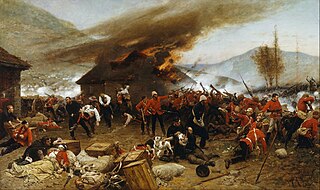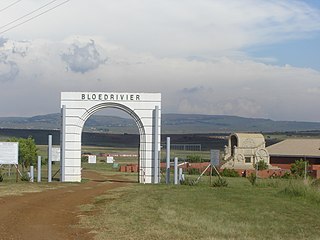 W
WThe Anglo-Zulu War was fought in 1879 between the British Empire and the Zulu Kingdom. Following the Constitution Act, 1867 for the federation in Canada, by Lord Carnarvon, it was thought that similar political effort, coupled with military campaigns, might succeed with the African kingdoms, tribal areas and Boer republics in South Africa. In 1874, Sir Bartle Frere was sent to South Africa as High Commissioner for the British Empire to effect such plans. Among the obstacles were the armed independent states of the South African Republic and the Kingdom of Zululand.
 W
WThe Battle of Hlobane took place at Hlobane, near the modern town of Vryheid in KwaZulu-Natal, South Africa during the Anglo-Zulu War.
 W
WThe Battle of Holkrans or Holkrantz took place at Holkrans, near Vryheid in KwaZulu-Natal, South Africa during the second Anglo-Boer War.
 W
WThe Battle of Kambula took place on 29 March 1879, during the Anglo-Zulu War, when a Zulu Army attacked the British camp at Kambula, having routed the mounted element of the British force at the Battle of Hlobane the day before. The battle was a decisive defeat and the Zulu lost their belief in victory. The war ended after the Battle of Ulundi on 4 July 1879.
 W
WThe Battle of Rorke's Drift, also known as the Defence of Rorke's Drift, was an engagement in the Anglo-Zulu War. The successful British defence of the mission station of Rorke's Drift, under the command of Lieutenants John Chard of the Royal Engineers and Gonville Bromhead, began when a large contingent of Zulu warriors broke off from their main force during the final hour of the British defeat at the day-long Battle of Isandlwana on 22 January 1879, diverting 6 miles (9.7 km) to attack Rorke's Drift later that day and continuing into the following day.
 W
WThe Battle of Ulundi took place at the Zulu capital of Ulundi on 4 July 1879 and was the last major battle of the Anglo-Zulu War. The British army broke the military power of the Zulu nation by defeating the main Zulu army and immediately afterwards capturing and razing the capital of Zululand, the royal kraal of Ulundi.
 W
WThe Battle of Blood River is the name given for the battle fought between 464 Voortrekkers ("Pioneers"), led by Andries Pretorius, and an estimated 10,000 to 15,000 Zulu on the bank of the Ncome River on 16 December 1838, in what is today KwaZulu-Natal, South Africa. Casualties amounted to over 3,000 of King Dingane's soldiers dead, including two Zulu princes competing with Prince Mpande for the Zulu throne. Three Voortrekker commando members were lightly wounded, including Pretorius.The year 1838 was the most difficult period for the Voortrekkers since they left the Cape Colony, till the end of the Great Trek. They faced many difficulties and much bloodshed before they found freedom and a safe homeland in their Republic of Natalia. This was only achieved after defeating the Zulu King, Dingane, at the greatest battle ever fought in South Africa, namely the Battle of Blood River, which took place on Sunday 16 December 1838.
 W
WThe Battle of Congella, beginning 23 May 1842, was between the British of the Cape colony and Voortrekkers or the Boer forces of the Natalia Republic. The Republic of Natalia sought an independent port of entry, free from British control and thus sought to conquer the Port Natal trading settlement which had been settled by mostly British merchants in modern-day KwaZulu-Natal. The battle ended in a British victory due to the heroic ride of Dick King for reinforcements.
 W
WThe Battle of Gqokli Hill was conducted in about April 1818, a part of the Mfecane, between Shaka of the Zulu nation and Zwide of the Ndwandwe, in Shaka's territory just south of present-day Ulundi.
 W
WThe Battle of Isandlwana on 22 January 1879 was the first major encounter in the Anglo-Zulu War between the British Empire and the Zulu Kingdom. Eleven days after the British commenced their invasion of Zululand in South Africa, a Zulu force of some 20,000 warriors attacked a portion of the British main column consisting of about 1,800 British, colonial and native troops and perhaps 400 civilians. The Zulus were equipped mainly with the traditional assegai iron spears and cow-hide shields, but also had a number of muskets and old rifles.
 W
WThe Battle of Maqongqo was fought on 29 January 1840 during a civil war between Zulu factions. The Zulu king Dingane was challenged for the throne by his brother Mpande, in alliance with Boer settlers led by Andries Pretorius. Mpande and his supporters were victorious. Shortly thereafter Dingane was murdered and Mpande became king of the Zulus.